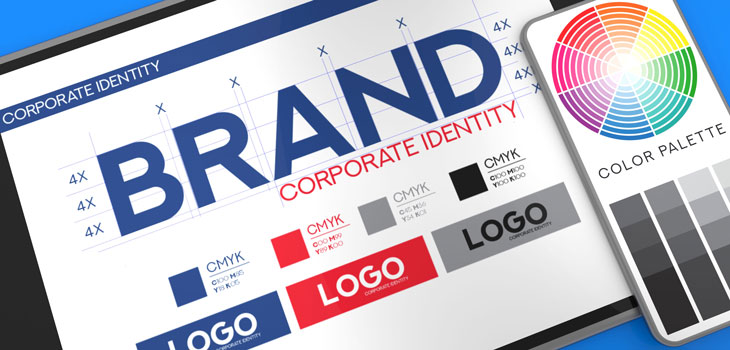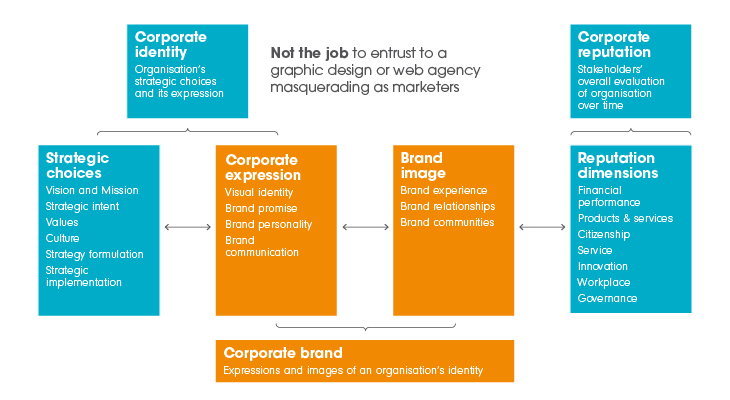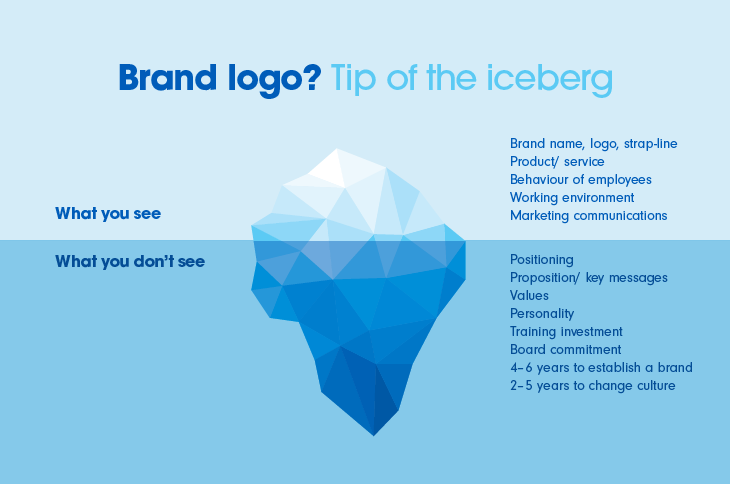
The notion of ‘branding’ has been woven through the fabric of marketing and business for so long now, it’s sometimes difficult to untangle ourselves from day-to-day experience and answer a question as fundamental as ‘What is branding?’
As marketing professionals, branding is simply what we do, and brands are the currency we deal in. Everyone understands what that means, right?
Well, yes. But ask a dozen marketers ‘What is branding?’ and you’re likely to get a dozen different answers. That’s not necessarily a problem. Branding involves many disciplines and specialist skills. So it’s no surprise people have differing views on what it is, depending on their role in it.
But having a broader picture of how to create and sustain a brand that will help your business compete and grow has got to be a good thing, yes?
So let’s start by stripping branding back to its basics with some 101 definitions before we move on to look at the complex interplay of elements that make up the branding process.
Defining ‘branding’ [hint: it’s not just your logo]
The American Marketing Association [AMA] defines a brand as a: “name, term, sign, symbol, or design, or a combination of them, intended to identify the goods and services of one seller or group of sellers and to differentiate them from those of competition.”
It’s a definition many would give in answer to the question ‘What is branding?’ But it lies at the heart of a misunderstanding many marketers fall victim to. And that’s the idea that branding is only about the creation of the logo and other visual brand elements.
Nothing could be further from the truth. And despite the fact many so-called branding agencies jump straight into designing brand visuals first, nothing is more dangerous for long-term brand health.

What is branding? It’s more than just your visual design assets
Yes, logos, typefaces, corporate colours and the rest are important. But they’re a long, long way from being a complete brand in their own right.
True branding goes much deeper. It’s about creating value, reputation, prominence and awareness that sustains your product or business and allows it to adapt and evolve as markets change.
The benefits of a well-defined brand
Experienced marketers know a powerful brand has a value beyond that of the products and services it’s attached to. Such things can be copied. But a well-defined brand occupies an unassailable place in the market.
More than that, it occupies an unassailable place in the minds of customers. In fact, it’s been said a brand’s real value lies not with the company behind it but in the customer’s head. So in answer to the question ‘What is branding?’ we can say it’s all the work that goes into sustaining or altering how customers think and feel about a particular company, service or product.

A brand’s true value lies in what customers think and feel about it
In a marketplace where customers face more and more choice, a strong brand can simplify their decision-making process and increase their loyalty by delivering a familiar experience.
And when a brand and the values it stands for are widely recognised, they don’t have to analyse the strengths and weaknesses of competing products. Instead, they can go straight to the brand they know will meet their expectations – the result of years, sometimes decades of careful brand management on the part of its parent company.
What role does branding play in B2B marketing?
Many of the ‘classic’ branding principles used by marketers today first emerged in the 1950s and 60s with the rise of mass consumerism.
Because of that, some marketers assume branding has less of a part to play in the B2B marketing world. But nothing could be further from the truth.
Just because B2B purchase decisions are often based on ‘rational’ considerations – cost, certification, availability and the like – branding still has a vital role.
The goodwill created by a positive brand for companies in B2B markets contributes to longer, stronger and more profitable commercial relationships.
And while appeals to the emotions aren’t common in B2B marketing, buyers can still be swayed by the sense of security they associate with a known brand – especially in uncertain economic times – or by the recognition and peer approval that comes from working with a top name in their sector.
So what is branding according to the marketing experts?
We’ve seen that branding is so much more than the visual representation of a company, product or service. And we know branding can affect the way customers think and feel about brands in different ways.
But what are the elements that need to be aligned to create and support a successful branding exercise?
An effective way of understanding the branding process is to look at the model created by authors Abratt and Kleyn in their paper: ‘Corporate identity, corporate branding and corporate reputations: Reconciliation and integration.’
They see branding as the integration of three cornerstone concepts: Corporate Reputation, Corporate Identity and Corporate Brand. Within each of these concepts, there are other elements at play, some familiar – like visual identity and brand communications – some less so.

What is branding? Abratt and Kleyn analyse all the elements of the branding process in this model
It all looks a bit complicated at first glance, so let’s break it down a little:
Corporate Reputation
Corporate Reputation is formed through all the encounters customers have with a brand, from its advertising and brand communications to its products, services and staff.
It’s also the result of a brand’s interactions with other stakeholders whose impressions are equally important.
Suppliers, for instance, will have a view about how a company negotiates with them, and how fairly it treats them.
Employees’ experiences of how a company lives its corporate values, their employment conditions, career development opportunities and the pride they feel in working there will also contribute.
And partners and affiliates will judge a brand on how well or badly it develops relationships and fulfils its promises to them.
All these things combine to create the overall Corporate Reputation of a business.
Corporate Reputation is the most important part of the branding cornerstones because it’s essential to long term sustainability and success. Products and marketing strategies can be tried and modified any number of times. But when a company’s reputation is damaged in the mind of the customer, it is much more difficult to recover.
Think of cases like VW’s emissions cover-up, where a nose-dive in Corporate Reputation was swiftly followed by plunging profits and share prices.
Corporate Brand
The next branding cornerstone, according to Abratt and Kleyn, is Corporate Brand. This is made up of two elements: Brand image [all the experiences and relationships customers have with a brand] and corporate expression – the visual identity, personality, tone of voice and other ways a brand projects itself.
Corporate Identity
The third and final cornerstone Abratt and Kleyn consider is Corporate Identity, a combination of two things: Corporate expression [outlined above], and an organisation’s strategic choices, consisting of its declared mission, values, culture and strategy.
Putting it all together
Of all the building blocks and subsets that make up Abratt and Kleyn’s model, corporate expression is probably the one marketers are most familiar with, as well as the one many design agencies pass off as ‘branding’ in its own right.
Yes, it can be tempting to rush for quick fix visual answers when the call comes to refresh your brand. But they can never be more than a cosmetic response to what are often much more fundamental problems in commercial and strategic direction.
We hope we’ve shown you, in looking at the question ‘What is branding?’, that it’s a far more involved discipline than choosing colours and typefaces for this year’s corporate ID. It requires the careful management of all the elements that make up the brand ecosystem above. And an understanding of how those elements interact to create and sustain a viable brand in a competitive marketplace.
If you’re used to dealing with your brand purely from the perspective of its visual language, the prospect of spinning all these additional branding plates could seem a daunting one. Which is where the insight and expertise of a truly strategic branding specialist are invaluable.
The strongest brands start with a clear branding strategy
The Intermedia branding method is rooted in a strategy first approach. In a nutshell, this means we do all our research and homework before we even think of creating visual brand outputs like logos, brand guidelines or packaging design.
That can be a long, involved process. Indeed, it should be if we’re to understand every aspect of your business, your commercial challenges, your competitors and the expectations of your customers.
The intention is to find a distinct space in the market your brand can occupy. And then exploit it to the maximum to drive sales, customer loyalty and market share.
To do that, our CIM certified branding experts will work closely with you and your team. We’ll help you hone your brand vision, develop its value proposition and explore ways to make it resonate in the most crucial space of all: your customers’ heads.
Even then, we don’t fire up the design software [or, for older readers, break out the layout pads.]
If you need us to, we’ll help you embed your new branding strategy throughout your organisation, so everyone from the canteen kitchen to the board room not only understands it, but embraces it.
Finding your visual brand language
When everything is aligned, and your branding strategy is in place, it’s time for our design team to put it all together in a unique visual identity. One that reflects your brand’s personality and position in the market, and reaches out to deliver your values wherever your customers see it.
It could be a brand you’re launching into a new sector. A refresh of an existing brand to bring it up to date for today’s audiences. Or a root and branch reappraisal of your entire corporate identity.
Whatever you need from them, our designers will deliver a stunning visual expression of your brand essence. It may only be the tip of the iceberg in the branding process. But guided by a robust strategy, and shaped by insightful creativity, it will be the difference between a brand that’s seen and embraced by your customers. And one that gets lost among the visual noise and clutter of today’s competitive business landscape.

A brand’s logo is one element of its communication
A quick recap: What is branding again?
If there’s one thing to take away from this article, it’s that branding is about so much more than logos, typefaces and colours. To summarise what we’ve covered:
- Visual design supports branding. But it isn’t branding in its own right
- Well defined branding makes customer decision-making easier and encourages customer loyalty
- The real power of a brand lies with how the customer thinks and feels about it
- Branding is just as important in B2B communications as in B2C
- The branding process is based on three cornerstones: Corporate Reputation, Corporate Brand and Corporate Identity
- Corporate Reputation is the most important of these cornerstones, because it is built on the experiences of customers and stakeholders, and is difficult to recover once damaged
- Branding is a strategic marketing function in its own right that will help you build sustainable, successful brands that make your business more profitable
Need help with your branding project?
When you want to understand the strategic principles behind the branding process, and carry them through into a distinctive, effective visual identity, having branding experts on the case makes all the difference.
Whether you need insight and advice on improving your brand as it stands or a full review of your complete brand portfolio, talk to Intermedia.
Originally published December 9, 2020
